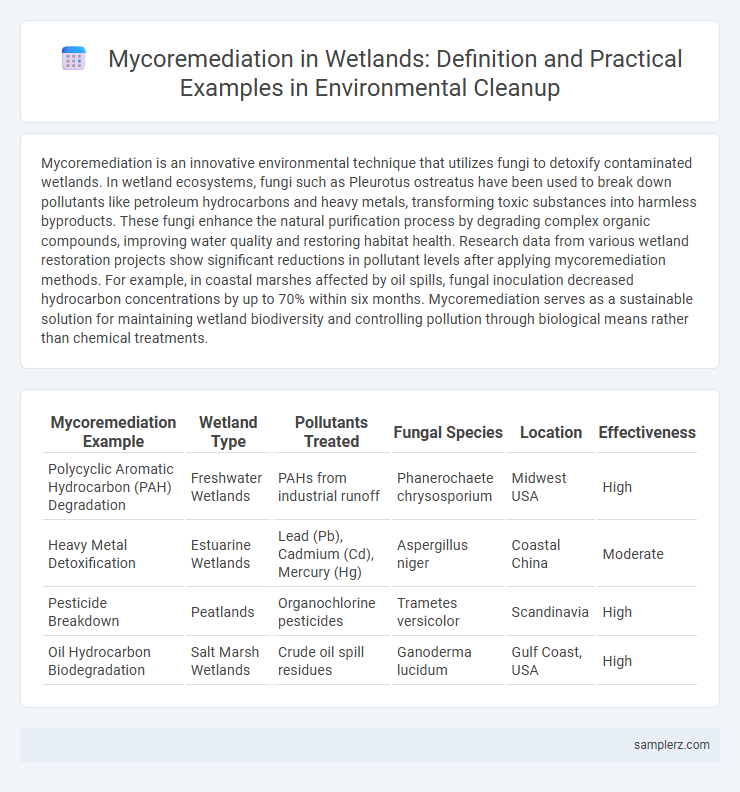Mycoremediation is an innovative environmental technique that utilizes fungi to detoxify contaminated wetlands. In wetland ecosystems, fungi such as Pleurotus ostreatus have been used to break down pollutants like petroleum hydrocarbons and heavy metals, transforming toxic substances into harmless byproducts. These fungi enhance the natural purification process by degrading complex organic compounds, improving water quality and restoring habitat health. Research data from various wetland restoration projects show significant reductions in pollutant levels after applying mycoremediation methods. For example, in coastal marshes affected by oil spills, fungal inoculation decreased hydrocarbon concentrations by up to 70% within six months. Mycoremediation serves as a sustainable solution for maintaining wetland biodiversity and controlling pollution through biological means rather than chemical treatments.
Table of Comparison
| Mycoremediation Example | Wetland Type | Pollutants Treated | Fungal Species | Location | Effectiveness |
|---|---|---|---|---|---|
| Polycyclic Aromatic Hydrocarbon (PAH) Degradation | Freshwater Wetlands | PAHs from industrial runoff | Phanerochaete chrysosporium | Midwest USA | High |
| Heavy Metal Detoxification | Estuarine Wetlands | Lead (Pb), Cadmium (Cd), Mercury (Hg) | Aspergillus niger | Coastal China | Moderate |
| Pesticide Breakdown | Peatlands | Organochlorine pesticides | Trametes versicolor | Scandinavia | High |
| Oil Hydrocarbon Biodegradation | Salt Marsh Wetlands | Crude oil spill residues | Ganoderma lucidum | Gulf Coast, USA | High |
Introduction to Mycoremediation in Wetlands
Mycoremediation in wetlands utilizes specific fungi species to break down pollutants such as heavy metals, pesticides, and hydrocarbons through enzymatic processes. These fungi colonize wetland soils and water, transforming toxic compounds into less harmful substances, thereby restoring ecological balance. Studies have shown that fungi like Phanerochaete chrysosporium significantly enhance the degradation of contaminants in wetland ecosystems.
Key Fungal Species Used for Wetland Remediation
Key fungal species used in wetland mycoremediation include Pleurotus ostreatus, known for its ability to degrade polycyclic aromatic hydrocarbons (PAHs), and Trametes versicolor, effective in breaking down lignin and removing heavy metals from contaminated water. Phanerochaete chrysosporium exhibits strong enzymatic activity for decomposing persistent organic pollutants, enhancing nutrient cycling and water purification. These fungi contribute to restoring wetland ecosystems by transforming toxic compounds into benign substances, improving soil and water quality.
Mechanisms of Mycoremediation in Aquatic Ecosystems
Mycoremediation in aquatic ecosystems utilizes fungal species like Trametes versicolor and Phanerochaete chrysosporium to degrade pollutants such as polycyclic aromatic hydrocarbons (PAHs) and heavy metals in wetlands. These fungi secrete extracellular enzymes like lignin peroxidase, manganese peroxidase, and laccase, which break down complex organic contaminants into less toxic compounds. The hyphal networks enhance contaminant adsorption and facilitate bioaccumulation, improving wetland water quality and restoring ecosystem health.
Case Study: Removal of Heavy Metals from Wetland Soils
Mycoremediation using white rot fungi has proven effective in removing heavy metals such as cadmium, lead, and mercury from wetland soils by breaking down complex contaminants and enhancing metal absorption. A case study conducted in a contaminated wetland in Florida demonstrated a 70% reduction in heavy metal concentration within six months of fungal inoculation. This method offers a sustainable and eco-friendly alternative for restoring wetland ecosystems affected by industrial pollution.
Mycoremediation for Organic Pollutant Degradation
Mycoremediation leverages fungi such as white-rot species to degrade organic pollutants like polycyclic aromatic hydrocarbons (PAHs) in wetland environments. Enzymes produced by these fungi break down complex organic contaminants into less toxic compounds, enhancing water quality and supporting ecosystem restoration. This process offers a sustainable method for detoxifying wetlands impacted by industrial runoff and agricultural waste.
Enhancing Nutrient Cycling with Fungi in Wetlands
Mycoremediation in wetlands enhances nutrient cycling by utilizing fungi to break down organic matter and recycle essential nutrients such as nitrogen and phosphorus. Fungal hyphae increase soil aeration and decomposition rates, promoting the growth of wetland plants and improving overall ecosystem productivity. Species like Trametes versicolor have demonstrated efficiency in degrading pollutants, fostering healthier wetland nutrient dynamics and water quality.
Success Stories: Mycoremediation of Oil-Contaminated Wetlands
Mycoremediation has proven highly effective in restoring oil-contaminated wetlands by using specific fungal species such as Phanerochaete chrysosporium and Pleurotus ostreatus, which degrade petroleum hydrocarbons into less harmful compounds. Successful case studies from wetlands in the Gulf Coast demonstrate significant reduction in total petroleum hydrocarbons (TPH) concentrations within months, enhancing soil and water quality. These fungi not only accelerate pollutant breakdown but also promote the recovery of native plant and microbial communities, reinforcing ecosystem resilience.
Challenges in Implementing Mycoremediation in Wetlands
Mycoremediation in wetlands faces challenges such as maintaining optimal fungal growth conditions amid fluctuating water levels and varying pollutant concentrations. The complex wetland ecosystem often hinders fungal colonization due to competition with native microbes and limited oxygen availability in saturated soils. Furthermore, scaling laboratory successes to field applications is complicated by the heterogeneous nature of wetland substrates and ongoing environmental disturbances.
Monitoring and Assessing Mycoremediation Effectiveness
Monitoring and assessing mycoremediation effectiveness in wetlands involves measuring fungal biomass, contaminant degradation rates, and changes in water and soil quality parameters. Using molecular tools like qPCR for fungal gene expression and bioassays for ecotoxicity helps quantify pollutant breakdown and ecosystem recovery. Continuous data collection on heavy metals, hydrocarbons, and nutrient cycles ensures accurate evaluation of fungal remediation impact on wetland health.
Future Prospects for Mycoremediation in Wetland Restoration
Innovative mycoremediation techniques using fungi such as Pleurotus ostreatus show significant potential for degrading pollutants and restoring wetland ecosystems affected by industrial runoff. Advances in fungal biotechnology and genomic studies enable the development of tailored fungal strains that enhance contaminant breakdown and improve soil health in wetland environments. Future research directed at optimizing fungal application methods could revolutionize sustainable wetland restoration efforts worldwide.

example of mycoremediation in wetland Infographic
 samplerz.com
samplerz.com